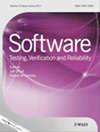关于新一代UI测试的特刊
IF 1.2
4区 计算机科学
Q3 COMPUTER SCIENCE, SOFTWARE ENGINEERING
引用次数: 2
摘要
市场对更快的交付和更高的软件质量的需求正逐渐变得越来越严格。软件公司满足这些需求的一个关键障碍是如何测试软件,这是由于测试软件的开发、维护和演变的内在成本,特别是因为测试软件应该被定义并与被测系统(SUT)的所有层对齐,包括所有用户界面(UI)抽象级别。基于ui的测试方法是端到端测试的形式。与系统的交互是通过模仿人类用户将执行的操作来实现的。关于图形用户界面(即GUI),根据用于创建测试定位器和预言器的GUI的抽象层,存在不同的基于GUI的测试方法:具体来说,第一代或基于坐标的测试使用屏幕上的确切位置来识别要与之交互的元素;第二代或基于布局的测试利用GUI属性作为定位器;第三代或视觉测试利用图像识别。这三种方法各有优缺点。尽管越来越多的学术证据表明它们的好处是互补的,但由于上面提到的成本,它们很少一起使用。然而,用户界面并不局限于gui,特别是随着最近用户界面的创新类型的扩散(例如,会话,语音识别,基于手势和文本的ui),仍然很少被开发人员测试;测试技术也可以根据生成测试脚本的方式来区分,也就是说,如果它们是在类似junit的测试脚本中编写的,或者是通过与SUT交互的捕获获得的,或者是自动地遍历用户界面的模型获得的,就像现代基于模型的测试工具所做的那样。测试自动化在工业环境中是一种根深蒂固的实践。然而,在一些软件开发领域,例如web和移动应用,UI测试仍然没有被系统地采用。许多文献调查的结果强调了开发人员对最先进的UI测试技术缺乏渗透的许多原因:1缺乏可用测试工具的文档;当保持测试脚本与AUT的发展保持一致时,重要的维护工作,例如,执行回归测试;当面对传统的手工测试时,对先进UI测试技术产生的好处的认识有限。本文章由计算机程序翻译,如有差异,请以英文原文为准。
Special issue on new generations of UI testing
Market demands for faster delivery and higher software quality are progressively becoming more stringent. A key hindrance for software companies to meet those demands is how to test the software due to the intrinsic costs of development, maintenance and evolution of testware, especially since testware should be defined and aligned, with all layers of the system under test (SUT), including all user interface (UI) abstraction levels. UI-based test approaches are forms of end-to-end testing. The interaction with the system is carried out by mimicking the operations that a human user would perform. Regarding graphical user interfaces (i.e., GUIs), different GUI-based test approaches exist according to the layer of abstraction of the GUI that is considered for creating test locators and oracles: specifically, first generation, or coordinate-based, tests use the exact position on the screen to identify the elements to interact with; second generation, or layout-based, tests leverage GUI properties as locators; and third generation, or visual, tests make use of image recognition. The three approaches provide various benefits and drawbacks. They are seldom used together because of the costs mentioned above, despite growing academic evidence of the complimentary benefits. User interfaces are, however, not limited to GUIs, especially with the recent diffusion of innovative typologies of user interfaces (e.g., conversational, voice-recognition, gesture-based and textual UIs) that are still rarely tested by developers; testing techniques can also be distinguished based on the way the test scripts are generated, i.e., if they are written inside JUnit-like test scripts or obtained through the capture of interactions with the SUT, or automatically obtained traversing a model of the user interface, as modern model-based testing tools do it. Test automation is a well-rooted practice in the industrial environment. However, there are software development domains, e.g., web and mobile apps, where UI testing is still not adopted on a systematic basis. The results of many investigations in literature highlighted many reasons for this lack of penetration of the most evolved UI testing techniques among developers: 1 Scarce documentation of the available testing tools; 2 Significant maintenance effort when keeping the test scripts aligned with the evolution of the AUT, e.g., for performing regression testing; 3 Limited perception of the benefits that advanced UI testing techniques yield when confronted with traditional manual testing.
求助全文
通过发布文献求助,成功后即可免费获取论文全文。
去求助
来源期刊

Software Testing Verification & Reliability
工程技术-计算机:软件工程
CiteScore
3.70
自引率
0.00%
发文量
34
审稿时长
>12 weeks
期刊介绍:
The journal is the premier outlet for research results on the subjects of testing, verification and reliability. Readers will find useful research on issues pertaining to building better software and evaluating it.
The journal is unique in its emphasis on theoretical foundations and applications to real-world software development. The balance of theory, empirical work, and practical applications provide readers with better techniques for testing, verifying and improving the reliability of software.
The journal targets researchers, practitioners, educators and students that have a vested interest in results generated by high-quality testing, verification and reliability modeling and evaluation of software. Topics of special interest include, but are not limited to:
-New criteria for software testing and verification
-Application of existing software testing and verification techniques to new types of software, including web applications, web services, embedded software, aspect-oriented software, and software architectures
-Model based testing
-Formal verification techniques such as model-checking
-Comparison of testing and verification techniques
-Measurement of and metrics for testing, verification and reliability
-Industrial experience with cutting edge techniques
-Descriptions and evaluations of commercial and open-source software testing tools
-Reliability modeling, measurement and application
-Testing and verification of software security
-Automated test data generation
-Process issues and methods
-Non-functional testing
 求助内容:
求助内容: 应助结果提醒方式:
应助结果提醒方式:


